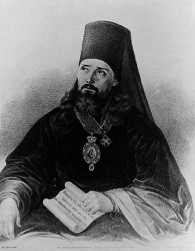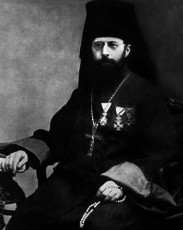St. Tikhon
Basil Belavin was born in Russia in 1865. He was ordained a Russian Orthodox priest in 1891, taking the name Tikhon. He was consecrated a bishop in 1897. In 1898 he was promoted to head the Orthodox Church in North America. Well liked, he was made an honorary citizen of the United States in 1900.
Bishop Tikhon visited Fort Ross in 1905 with Father Theodore Pashkovsky. The duo was pleasantly surprised to find the Chapel had been returned to a religious theme. Father Pashkovsky commented on "the cleanness of the chapel." "Gone was "the desolation of a holy place", as Bishop Nikolai had commented only eight years before. The improvements had resulted from the acquisition of the Fort by the State of California which turned it into a state park.
Like Bishop Nicholas and Father Dabovich, Bishop Tikhon and Father Pashkovsky spent the night at the Fort Ross Hotel and returned to San Francisco the following day.
He was reassigned to Russia in 1907 and in 1913 was assigned to the Bishopric of Lithuania. On 1917 on the eve of the Russian revolution he was elected to be Metropolitan of the Russian Orthodox Church. As the church's Patriot he was the highest ranking cleric of the church. During his tenure he witnessed the Great Russian Civil War and rise of the Communist Party which repressed the Church. The Soviets confiscated Church property and persecuted and imprisoned thousands of the clergy. Thousands of churches were forcibly closed by the Soviet government. Bishop Tikhon himself was imprisoned for over a year.
He died in Russia in 1925 at the age of 60. He was canonized a saint in 1989.
They Walked the Walk
In retrospect St. Innocent, Blessed Dabovich and St. Tikhon had their trips to Fort Ross in common with their sainthood. They all took the time to record their observations for posterity. Since 1900, hundreds of Orthodox clerics tens of thousands of believers and Russian citizens have visited the "rather plain" chapel perched on the promontory overlooking the mighty Pacific Ocean. The distinctive chapel has been repaired and rebuilt. The cemetery has been studied by scholars and partially reclaimed. In 1897, Bishop Ziorov observed that looking back from the cemetery towards the Fort was "a charming picture." He enjoyed the murmuring brook and open field "covered with a motley rug of green and flowers and the setting sun with slanted rays that gilded the ocean, the Fort, the forest and us." Amazingly, things haven't really changed much since then.
The Author acknowledges and thanks Mikhail Pashkov and Alex Liberovsky for their assistance.
St Innocent
Ioann Veniaminov, a 39 year old Russian Orthodox priest, departed Sitka, Alaska onboard a Russian schooner on July 1, 1836. Alaska was then a Russian colony. On the second day at sea, Veniaminov related in his journal, "we received a tailwind and the weather was good. The weather stayed with us all the way and was so favorable that we raced across a distance of 150 to 200 miles per day." Fifteen days later he disembarked at Bodega Bay, California and spent the next five hours on horseback riding at "a moderate gait." When he arrived at Fort Ross that July afternoon, he had traveled 1,100 miles.
Veniaminov, who spent five weeks at the fort, was only the second Orthodox prelate to visit the colony since its founding in 1812. While there he celebrated the liturgy and gave communion, performed and blessed marriages, heard confessions, baptized and taught religion prepatory to the various sacraments. He blessed the stream and the fort. He liked Fort Ross, admitting "the healthful air, the pure blue sky, the geographical position and native vegetation struck and captivated" him. Although he was disappointed with the chapel which he found "rather plain."
He was an inquisitive man "full of scientific curiosity, observant, tireless and exact in collecting data." He was also a gifted linguist. He left Fort Ross by horse, traveling to San Francisco. He spent another two weeks in the San Francisco Bay Area, visiting and befriending Catholic padres at four Franciscan missions (San Rafael, San Francisco's Mission Dolores, San Jose and Santa Clara.). It took 30 days to sail back to Sitka.
Back in Alaska he took the time to use his mechanical skills, building two small pipe organs which he donated to two of the California missions he had visited (San Jose and Santa Clara)- "a rare gesture of ecumenical goodwill for the time."
In 1841-the same year the Russians abandoned Fort Ross-Father Veniaminov was made Bishop of Kamchatka and the Kuril Islands of Russia and the Alaskan Aleutian Islands. As is the custom in the Russian Orthodox Church, he chose the Bishopric name of Innocent. In 1850 he was elevated to Archbishop and in 1869 was appointed Metropolitan of Moscow, the highest rank in the Russian Orthodox Church. He died in 1879 at the age of 82. He was canonized a saint in 1977.
Blessed Dabovich
Jovan Dabovich was born in San Francisco in 1863 to Serbian immigrant parents. He was ordained an Orthodox priest in 1892. He was the first American to be ordained an Orthodox priest. Upon ordination he took the name Sebastian. In 1897 the young priest accompanied his Bishop Nicholas Ziorov on a trip from San Francisco to Fort Ross. The trip included a ferry boat ride from San Francisco to Sausalito, California. There the clerics boarded a train which took them over the coastal range along Tamales Bay, California and inland to Cazadero, California. From Cazadero they took a stagecoach up Fort Ross Road. The entire trek from San Francisco took about fifteen hours.
Bishop Ziorov has left us an accurate account of the trip and his impressions. They only spent a day and a night at the Fort. Like St. Innocent, he enjoyed the trip and surroundings; "Such air, such nature, an enchantment!" he wrote. He gasped when he caught his first sight of the fort: "It stands on a hillock as if in the (palm) of God's hand above the ocean."
Ziorov and Dabovich were disappointed with the condition of the chapel and cemetery, both of which had degraded significantly in the fifty odd years since the colony was abandoned by the Russians. The chapel, in disrepair, had been turned into a barn for animals. When they visited the cemetery they saw further disrepair with "only insignificant remains" of unkempt graves. Dabovich "emotionally" performed an Orthodox religious rite over the cemetery graves- "with difficulty he pronounced the prayers." Ziorov expressed anger at "the desolating sacrilege in a holy place." Dabovich wrote in the Fort Ross Hotel Register, "I have had the honor to visit this place and pray in the old cemetery yonder on the hill." He laments that he couldn't pray in the chapel "which is now a house of cattle."
Dabovich had an interesting religious career after his visit to Fort Ross. He spent time in Minnesota, returned to San Francisco and organized the first Serbian Orthodox church in Jackson, California. Later he spent time in Alaska, Chicago and New Jersey. In 1914 he became a chaplain in the Serbian Army and after World War I served the remainder of his life in Yugoslavia. He died there in 1940 at the age of 77. In 2007 his remains were unearthed in Serbia and brought back to California. They were reinterred at St. Sava Church in Jackson. He is currently being considered for Canonization as a Saint in the Orthodox Church. If and when "sainted," he will be the first American so honored in the Russian Orthodox Church.
One came by schooner, and then horseback. Two came by steam locomotive, and then stagecoach. Holy men on a mission-they came, they prayed and departed. Their presence at Fort Ross, Russian colony turned California State Park, is exceptional. It is the only public park in the United States that has been graced by three saints. In a sense, Fort Ross is a kind of hallowed ground.



THE SAINTS OF FORT ROSS



By Daniel J. Demers - All Rights Reserved ©Copyright 2011
St Innocent
Visited Fort Ross in 1836
Blessed Dabovich
Visited Fort Ross in 1897
Saint Tikhon Dabovich
Visited Fort Ross in 1905
E-MAIL ME ddemers901@sonic.net

